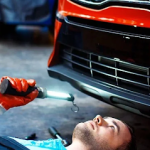In the quest for enhanced vehicle performance, active yaw control stands as a revolutionary technology that dramatically improves a vehicle’s handling and stability. This advanced system, which is primarily designed to control the vehicle’s yaw rate and minimize sideslip, has now become a critical component in high-performance vehicles. Yet, the question still stands – how should you test and maintain these complex systems to ensure optimal performance?
Understanding the Active Yaw Control System
Before delving into the testing and maintenance procedures, let’s first kindle a basic understanding of what an active yaw control system is and how it operates. Essentially, the active yaw control system is an advanced version of the traditional power-steering system. It manipulates the steering angle of the vehicle’s wheels based on various parameters, such as speed, vehicle dynamics, and driver input.
Also to discover : How often should the wheel studs be inspected and replaced in a vehicle used for track racing?
The system uses a yaw rate sensor to measure the vehicle’s rotational speed around its vertical axis. The sensor captures the yaw rate and sends this data to the vehicle’s Electronic Control Unit (ECU). Depending on the yaw rate, the ECU then adjusts the power provided to the vehicle’s steering wheel to manipulate the vehicle’s yaw motion and maintain stability.
The active yaw control system is significantly influenced by the sideslip angle, which is the angle between the vehicle’s actual direction of motion and the direction towards which it is pointing. Managing the sideslip angle is crucial for maintaining vehicle stability, especially during cornering at high speeds.
In the same genre : What are the safety protocols for handling and disposing of electric vehicle components post-accident?
The Importance of Testing Active Yaw Control Systems
Active yaw control systems are intricate and sophisticated, requiring regular testing to ensure accurate functioning. Regular testing helps to detect any potential issues early and allows for prompt remedial action. This can prevent any potential risks associated with faulty yaw control systems, such as unpredictable vehicle behavior or loss of control.
When testing the active yaw control system, two primary aspects need to be evaluated: the yaw rate and the sideslip angle. Both should correspond to the vehicle’s actual behavior and the driver’s steering input. For instance, if the vehicle is turning to the left, the yaw rate should also indicate a left turn.
Even the smallest discrepancies in these parameters can have a significant impact on the vehicle’s handling and stability. For instance, if the yaw rate sensor gives an incorrect reading, it can lead to the steering wheel being turned more or less than necessary, causing the vehicle to oversteer or understeer.
Techniques for Testing Active Yaw Control Systems
There are multiple ways to test active yaw control systems, and the method employed often depends on the vehicle’s model and the individual system’s complexity. One of the most common techniques involves using a diagnostic tool that can read and interpret the data from the vehicle’s ECU.
This tool can display the yaw rate in real-time, helping to identify any discrepancies between the actual and indicated rates. By comparing the readings from the tool with the vehicle’s actual performance, any irregularities in the yaw rate can be identified and addressed.
Sideslip angles can be tested using a similar approach. Some advanced diagnostic tools can simulate various driving conditions and observe how the active yaw control system responds. This can help to identify any potential issues with the system’s ability to manage the sideslip angle.
Maintaining Active Yaw Control Systems
Maintenance of active yaw control systems is just as important as testing. Regular maintenance can prevent potential issues and prolong the system’s life. The maintenance procedure primarily involves checking and replacing various components of the system as needed.
One key aspect of maintaining an active yaw control system is regularly checking the yaw rate sensor. Over time, this sensor can become less accurate due to wear and tear, potentially leading to inaccurate yaw rate readings. Therefore, it’s necessary to check the sensor’s performance regularly, and if any inconsistencies are detected, it should be replaced.
The vehicle’s ECU, which processes the yaw rate data and adjusts the vehicle’s steering accordingly, also needs regular maintenance. This typically involves updating the ECU’s software to ensure it can correctly interpret the yaw rate data and respond appropriately.
Lastly, the system’s mechanical components, such as the steering wheel and the power steering system, should also be checked regularly. Any worn-out parts should be replaced, and the entire system should be lubricated to ensure smooth operation.
Overall, maintaining and testing active yaw control systems requires a meticulous approach and a comprehensive understanding of the system’s operation. By regularly testing and maintaining these systems, you can ensure that your performance vehicle continues to deliver optimal handling and stability.
Implementing the Active Yaw Control System Testing
When it comes to implementing the testing of active yaw control systems, there are specific considerations and techniques to bear in mind. As previously mentioned, the system’s yaw rate and sideslip angle are the primary aspects evaluated during testing. These parameters provide valuable insights into how the system is performing in real-time, and any discrepancies can significantly affect vehicle stability.
One way to conduct this test is through the use of advanced diagnostic tools. These devices can connect to the vehicle’s ECU, reading and interpreting data to provide real-time feedback on the yaw rate. By comparing this feedback with the driver’s actual inputs and the real-world performance of the vehicle, you can identify any irregularities in the yaw rate.
Similarly, the sideslip angle can also be tested using these diagnostic tools. They can simulate different driving conditions, such as cornering at high speeds or driving on slippery surfaces, and observe how the active yaw control system responds. For instance, if the vehicle begins to understeer or oversteer in these simulated conditions, it may indicate an issue with the system’s ability to manage the sideslip angle.
Additionally, research from publications like IEEE Transactions and other scholarly resources, suggest methods such as the sliding mode control for testing active yaw control systems. This involves creating a mathematical vehicle model and applying different lateral acceleration scenarios to observe the system’s response.
In this process, the sliding surface is determined based on the desired yaw rate and the actual yaw rate. By observing how quickly the system can bring the vehicle back to the sliding surface (i.e., eliminate the error), the effectiveness of the active yaw control system can be evaluated.
Conclusion: The Importance of Regular Testing and Maintenance
The active yaw control system is a revolutionary technology in the realm of performance vehicles. It plays a crucial role in improving a vehicle’s stability and handling, which directly impacts the overall driving experience. However, like any advanced technology, these systems require regular testing and maintenance to ensure they continue to perform optimally.
Testing should primarily focus on the yaw rate and sideslip angle, as these parameters are key in determining the system’s effectiveness. Techniques such as using diagnostic tools and sliding mode control can help identify any discrepancies or potential issues in the system’s operation.
On the other hand, regular maintenance plays a vital role in prolonging the system’s life and preventing potential issues down the line. This includes inspecting and replacing components such as the yaw rate sensor and the vehicle’s ECU, as well as the mechanical components of the steering system.
In conclusion, the testing and maintenance of active yaw control systems should be a regular part of the upkeep of performance vehicles. By diligently implementing these practices, you can ensure that your vehicle continues to deliver excellent performance and stability.












